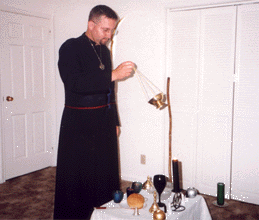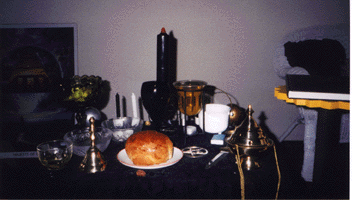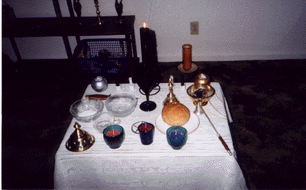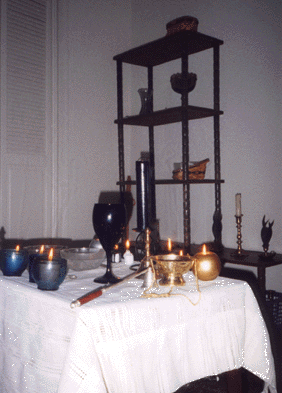

 |
The first thing you should do is consecrate the area in which you will be placing your altar. We are fortunate enough to be able to devote an entire room to the Craft. In this room, we have our altar, a side altar, our Craft books, and in the closet, we hang our ritual robes. In addition, we have hung on the walls things that are sacred to us: pictures we've drawn or painted, dried flowers, pictures of our coven mates, and much more. In order to consecrate your sacred space, you will need:
|

 |
Imbolc This was our how our altar looked when we celebrated Imbolc. This is kind of a dark picture. The large green dish is our libation dish. Cakes and ale not consumed during ritual are put in here, and given to the earth so that the Gods may partake of our offering. The table on the right holds our Book of Shadows. The tall black candle is our source candle, and you can see the chalice in front of it. On the left is our bell. The dish of yellow liquid was used in the Sabbat ritual to represent the returning sun. Also prominent is the loaf of bread. David bakes every loaf of bread we used in ritual. |
 |
Ostara This is how our altar looked at Ostara. The first thing you'll notice is that we don't have a loaf of bread on the table. Instead, we used cookies shaped like bunnies, chicks, and eggs. When the flowers had dried out, we placed them in a vase that hangs from the wall. On the lower right corner of the altar, you'll see some little bunny tailsmans. We painted them, and charged them with energy. They were actually magnets, and all of us still have them hanging on our refrigerators. |

 |
Midsummer This is how our altar looked for Midsummer. By Midsummer, our temple had gotten a little more elaborate. This was due to an increase in our Coven size. The book case behind the altar acts as a side altar. We keep matches, incense, extra candles, the libation dish and many other things on it. This picture clearly shows our God and Goddess candles, as well as the athame, chalice, and pentacle. This is before we got our wand. You can also see the dishes of salt, water and oil. This is also a good example of how to be resourcful when you are an urban pagan. The three candles on the front of the altar represent a bonfire. We could not have possibly lit a bonfire indoors, so we improvised. :-) Behind the altar, you'll see one of our quarter candles. This is actually the candle for the south, not the east, which is the direction our altar faces. I'm not sure why it's there, but it gives you an idea about how to mark the quarters. You'll also notice that I have a candle snuffer on the altar. Candles used during ritual should never be blown out, but should be extinguished. If you just light a candle to read by, it's fine to blow it out. But when you do ritual or spell work, NEVER blow out your candles! Just behind the snuffer is the censor. In this picture, it has the top off (in the picture at the top, you can see the lid laying on the left side of the altar). We use a censor that had chains on it so that we can swing it. Swinging the censor helps the charcoal burn better, and makes it easier to bless the room (refer to the picture at the very top of the page. This is David blessing our altar before Midsummer). |